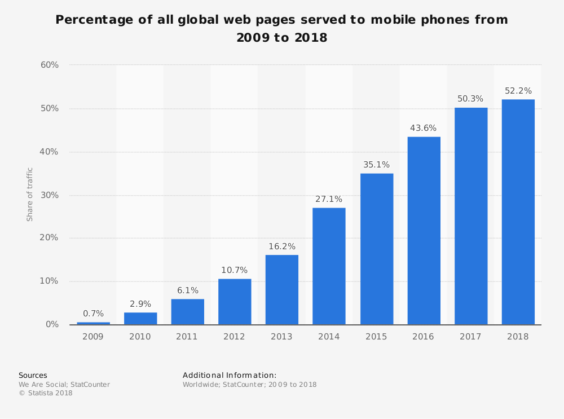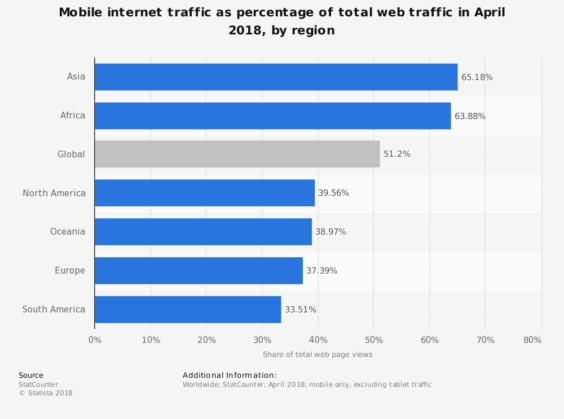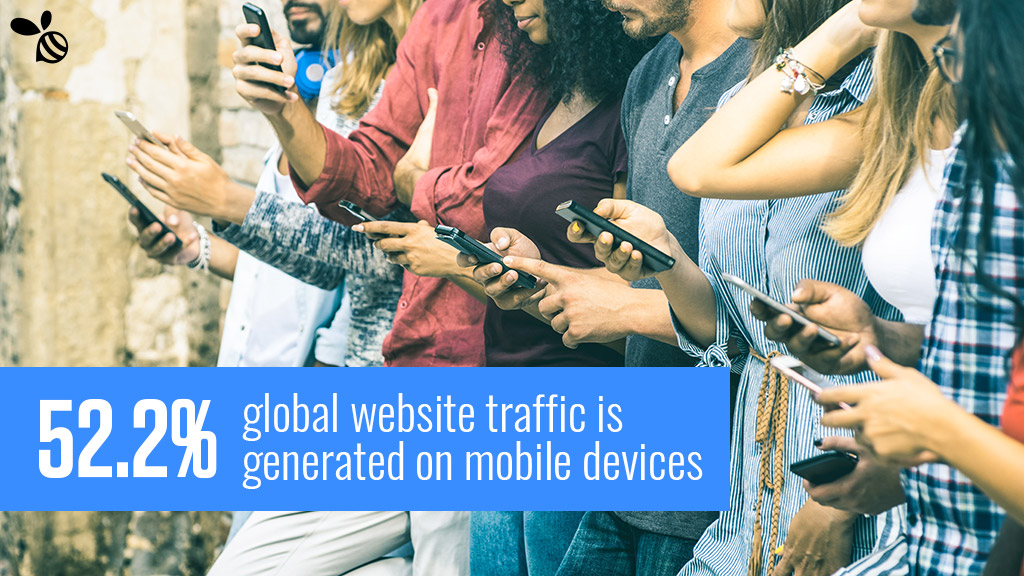52.2% of all website traffic was generated through mobile devices in 2018, according to Statistica. This is up dramatically. In 2015 mobile traffic accounted for 35.1%, and in 2012 it was a paltry 10.7%.
 Marketers look at these stats and loudly proclaim, “Mobile First!”
Marketers look at these stats and loudly proclaim, “Mobile First!”
They argue that companies have to design websites, content, and marketing campaigns for mobile devices first. The assumption is, “No one uses their desktop and laptop computers to surf the web anymore.”
But before you dive onto the mobile first bandwagon, let’s challenge the numbers. Your customer may not be as mobile dependent as the 52.2% statistic indicates.
Not All Markets Are Mobile First
 The global average is 52.2%, but the number swings widely depending on what country you consider.
The global average is 52.2%, but the number swings widely depending on what country you consider.
Statistica shares mobile website traffic by region. As of April 2018, 65.2% of all web traffic in Asia was on mobile devices, and it was 63.9% in Africa.
In North America, 39.6% of website traffic is conducted on mobile, and it’s 37.4% in Europe.
This is a huge gap! While mobile is incredibly important, it’s not as dominant as the stats may indicate, at least in North America and Europe.
B2B Buyers Surf During the Day
The mobile first premise skews even further for B2B brands.
Consider your day-to-day activities. How much time do you spend at the office searching professional sites from your phone?
The average office worker is affixed to their desktop or laptop computer for most of the day. They use their PC for a variety of applications: email, presentations, documentation, video conference calls, programming, or accessing business applications.
Office workers do use their mobile devices a lot, but are they researching and making buying decisions for B2B products from their phones?
A good exercise to answer this question is to dig into your Google Analytics for the past 12 months:
- What percentage of users accessed your site from a mobile or tablet device?
- What time of day are visitors frequenting your website?
Many B2B brands are surprised to see 80% or more of their website traffic is originating on desktop computers between 9am and 5pm.
You Can’t Ignore Mobile
Your customers may not be engaging with your brand on mobile first, but that doesn’t mean you can ignore mobile either.
On March 26, 2018, Google officially announced that they are using mobile first indexing. Google explains, “Our crawling, indexing, and ranking systems have typically used the desktop version of a page’s content … Mobile-first indexing means that we’ll use the mobile version of the page for indexing and ranking, to better help our – primarily mobile – users find what they’re looking for.”
Google is operating from a mobile first premise, which means if you want your website to rank high in Google’s search results then you better have a great mobile site.
Customers are also evaluating your brand across multiple screens. For B2B brands, your customers may spend the bulk of their time looking at your website from a desktop computer, but that doesn’t mean they won’t look you up from their phone or tablet too.
Avoid Simplistic Proclamations
The big problem with proclaiming a “mobile first strategy” is it ignores the complexity of the situation.
Yes, mobile is important. Google tells you so. But that doesn’t mean your customers are actually buying your products and services from their phones.
Build your marketing strategy in context:
- What do your customers expect?
- How do they interact with your brand?
- How can you deliver exceptional buying experiences?





